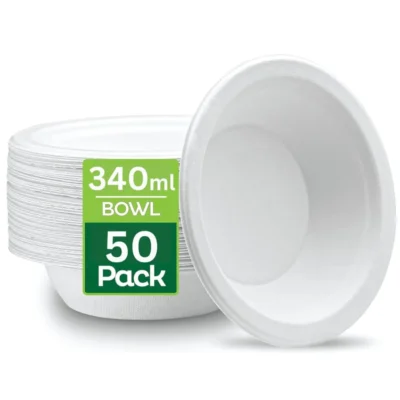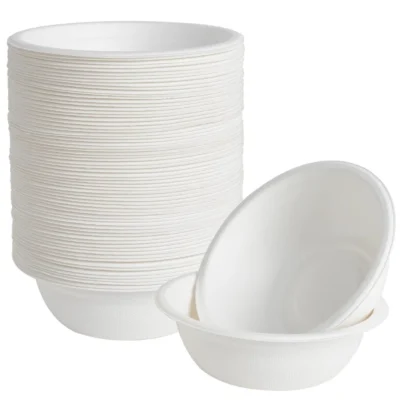Bagasse Bowls
Explore our eco-friendly Bagasse bowls, made from sugarcane fiber and perfect for serving hot or cold foods. These biodegradable and compostable bowls are ideal for takeaways, parties, and catering events. Choose Bagasse bowls for a sustainable, sturdy, and microwave-safe alternative to plastic and foam containers.
Products: 240ml • 340ml • 900ml

Disposable Bagasse Bowls

Bagasse Bowls (340ml)
£6.99 – £22.99Price range: £6.99 through £22.99Select options This product has multiple variants. The options may be chosen on the product page
Bagasse Bowls (240ml)
£5.99 – £21.99Price range: £5.99 through £21.99Select options This product has multiple variants. The options may be chosen on the product page
Disposable Bagasse Bowls for Sustainable and Eco-Friendly Dining Solutions
Disposable bagasse bowls are made from the fibrous residue left after extracting juice from sugarcane. They offer a natural and eco-friendly alternative to plastic or foam containers. These bowls are biodegradable, compostable, and safe for both hot and cold foods, making them a practical choice for those who want to reduce waste.
They are sturdy, lightweight, and can be used in many settings such as picnics, parties, or takeaways. Unlike traditional disposable bowls, bagasse bowls break down quickly after use, helping to lower environmental impact. Many businesses now prefer them to meet growing demand for sustainable packaging.
With increasing concern about single-use plastics, bagasse bowls provide a reliable option that balances convenience with environmental care. Their natural texture and strength make them suitable for daily use, while supporting greener practices.
Understanding Disposable Bagasse Bowls
Disposable bagasse bowls are made from the fibrous material left after sugarcane juice is extracted. They offer a sustainable alternative to traditional disposable plates and other single-use containers. The production process, material properties, and comparisons help explain their benefits and limitations.
What Is Bagasse?
Bagasse is the dry pulp that remains once sugarcane stalks are pressed for juice. It is mostly made up of fibres such as cellulose, hemicellulose, and lignin. Bagasse is widely available as a by-product of the sugar industry, making it a low-cost, natural resource.
Because it is organic and biodegradable, bagasse is suitable for making disposable tableware. It breaks down faster than plastic and does not release harmful chemicals when disposed of. Its fibrous texture also provides good strength and heat resistance, ideal for holding hot or cold food.
Manufacturing Process of Bagasse Bowls
Bagasse bowls are created by heating and compressing wet bagasse fibres into molds. The process involves cleaning the raw bagasse and mixing it with water to form a pulp. This pulp is then shaped under heat and pressure without needing harmful chemicals or plastic additives.
The result is a sturdy and leak-proof bowl. After moulding, the bowls dry and cool before being trimmed and packed. This method is energy-efficient and uses renewable materials, reducing waste compared to plastic or paper alternatives.
Comparison with Disposable Plates and Bagasse Plates
Bagasse bowls differ from disposable plates mainly in shape but share similar production methods and materials. Both use bagasse pulp and provide compostable options for single-use food containers.
Compared to regular disposable plates made from plastic or coated paper, bagasse bowls are more environmentally friendly. Plastic plates take hundreds of years to decompose, whereas bagasse breaks down within a few months in a composting environment.
Disposable bagasse bowls are a sustainable choice, especially for those seeking eco-friendly options in single-use food service products.
Benefits and Uses of Disposable Bagasse Bowls
Disposable bagasse bowls offer a practical solution for serving food while reducing environmental impact. They are made from sugarcane fibres, making them an alternative to plastic and foam containers. Their design meets the needs of businesses and individuals seeking sustainable options.
Environmental Advantages and Sustainability
Bagasse bowls come from sugarcane waste, a by-product, which means they use material that would otherwise be discarded. This reduces reliance on non-renewable resources like oil, which is used in plastic production. They are considered environmentally friendly because their production process emits less carbon compared to plastics.
These bowls help prevent plastic pollution, especially when used in single-use food packaging. Using them supports efforts to reduce landfill waste and lowers overall environmental damage tied to disposable packaging materials.
Compostable and Biodegradable Features
Bagasse bowls are fully compostable. After use, they break down naturally in industrial and home compost settings. This allows food waste and packaging to be composted together, unlike plastic containers that do not decompose.
Their biodegradability means they return to the soil without leaving harmful residues. This feature gains importance as more organisations, such as the Ice Cream Alliance, recommend sustainable packaging that meets composting standards.
Practical Applications: Parties, Caterers, and Takeaway Supplies
Disposable bagasse bowls are popular for parties and events because they are sturdy and heat resistant. Caterers rely on them for serving hot and cold food due to their durability and eco-friendliness. TakeawaySupplies.co.uk offers these bowls to businesses seeking green packaging solutions.
They work well for various food types, including salads, soups, and ice cream. Their neutral colour also pairs easily with branding or disposable cutlery, making them suitable for any catering or takeaway setting.
Selecting the Right Pack: Pack of 50 and Other Options
Choosing the right pack size depends on the event or business size. A pack of 50 bowls suits small to medium events or catering orders. Larger operations may prefer bulk packs for cost efficiency and convenience.
Suppliers like TakeawaySupplies.co.uk offer multiple pack sizes, including 25, 50, and 100, allowing buyers to pick what fits their needs best. Bulk buying also helps reduce packaging waste and lowers the carbon footprint per bowl.


